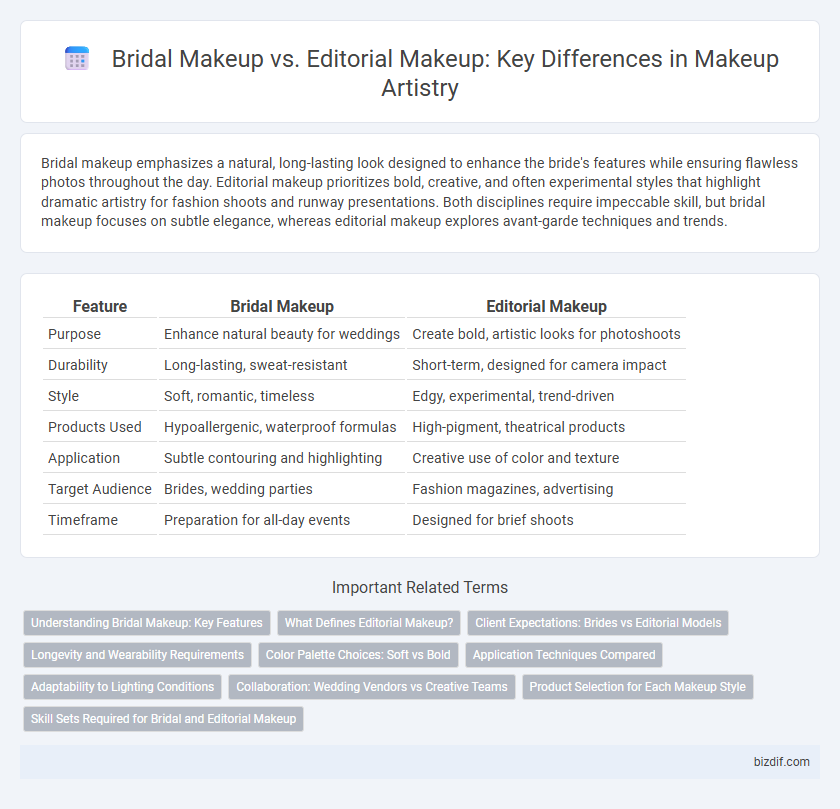Bridal makeup emphasizes a natural, long-lasting look designed to enhance the bride's features while ensuring flawless photos throughout the day. Editorial makeup prioritizes bold, creative, and often experimental styles that highlight dramatic artistry for fashion shoots and runway presentations. Both disciplines require impeccable skill, but bridal makeup focuses on subtle elegance, whereas editorial makeup explores avant-garde techniques and trends.
Table of Comparison
| Feature | Bridal Makeup | Editorial Makeup |
|---|---|---|
| Purpose | Enhance natural beauty for weddings | Create bold, artistic looks for photoshoots |
| Durability | Long-lasting, sweat-resistant | Short-term, designed for camera impact |
| Style | Soft, romantic, timeless | Edgy, experimental, trend-driven |
| Products Used | Hypoallergenic, waterproof formulas | High-pigment, theatrical products |
| Application | Subtle contouring and highlighting | Creative use of color and texture |
| Target Audience | Brides, wedding parties | Fashion magazines, advertising |
| Timeframe | Preparation for all-day events | Designed for brief shoots |
Understanding Bridal Makeup: Key Features
Bridal makeup emphasizes long-lasting, flawless coverage designed to enhance natural beauty and withstand hours of wear, focusing on soft, romantic tones that complement wedding attire and photography. It prioritizes sweat-proof, transfer-resistant formulas and subtle highlighting to ensure the bride looks radiant throughout her special day. Skilled bridal artists tailor looks to individual skin types and cultural traditions, creating timeless elegance rather than dramatic effects found in editorial styles.
What Defines Editorial Makeup?
Editorial makeup is defined by its bold, creative, and often avant-garde approach, designed to capture striking visuals for fashion magazines, advertisements, and photo shoots. It emphasizes artistic expression, innovative use of colors, textures, and techniques to complement the theme or concept of the editorial. Unlike bridal makeup, which focuses on enhancing natural beauty and longevity for the wedding day, editorial makeup pushes boundaries to create dramatic, high-impact looks tailored for camera and artistic storytelling.
Client Expectations: Brides vs Editorial Models
Bridal makeup prioritizes long-lasting, natural-enhancing looks designed to withstand emotional moments and photography throughout an entire wedding day, ensuring the bride feels radiant and confident. Editorial makeup embraces bold, avant-garde styles tailored for high-fashion photo shoots, emphasizing creativity and striking aesthetics to capture the photographer's vision. Brides expect durability and elegance suited to personal significance, while editorial models anticipate transformative, trend-setting artistry that pushes conventional beauty boundaries.
Longevity and Wearability Requirements
Bridal makeup prioritizes long-lasting wearability to withstand hours of ceremonies, photos, and emotional moments while maintaining a flawless appearance. Editorial makeup emphasizes creative expression with bold, high-impact looks designed for short durations under intense lighting, often sacrificing longevity for visual effect. Products with waterproof, transfer-resistant formulas are essential for bridal makeup, whereas editorial makeup allows for frequent touch-ups to maintain the desired artistic impact.
Color Palette Choices: Soft vs Bold
Bridal makeup color palettes typically emphasize soft, romantic shades such as blush pinks, warm nudes, and gentle champagne tones to enhance natural beauty and create a timeless look. Editorial makeup favors bold, dramatic colors including vivid reds, deep purples, and striking metallics to produce high-impact visuals that stand out on camera. The contrast in color choices reflects the differing purposes: subtle elegance for bridal artistry versus creative expression for editorial shoots.
Application Techniques Compared
Bridal makeup application emphasizes long-lasting, natural-looking finishes with techniques like oil-free primers, waterproof formulas, and subtle contouring to ensure durability and elegance throughout the wedding day. Editorial makeup techniques prioritize bold, artistic expression, utilizing layering, heavy pigments, and innovative textures for striking visual impact in high-definition photography. Skillful blending, precise brushwork, and customization for lighting conditions differentiate the application methods tailored to each makeup style's purpose.
Adaptability to Lighting Conditions
Bridal makeup is designed to enhance natural beauty and remain flawless under various real-life lighting conditions, including daylight, indoor lighting, and flash photography, ensuring the bride looks radiant throughout the event. Editorial makeup, by contrast, is tailored for controlled studio environments with professional lighting setups, allowing for more dramatic and artistic expressions that may not translate well outside those conditions. The adaptability to lighting in bridal makeup prioritizes longevity and subtlety, while editorial makeup emphasizes striking impact and creativity under specific lighting scenarios.
Collaboration: Wedding Vendors vs Creative Teams
Bridal makeup artists collaborate closely with wedding vendors such as photographers, planners, and florists to ensure a cohesive aesthetic that complements the wedding theme and enhances the bride's natural beauty. Editorial makeup artists work alongside creative teams including fashion designers, stylists, photographers, and art directors to create bold, conceptual looks that align with the artistic vision of photo shoots or runway shows. Effective collaboration in bridal makeup centers on harmonizing with event details, whereas editorial makeup requires dynamic teamwork to achieve innovative and visually striking results.
Product Selection for Each Makeup Style
Bridal makeup prioritizes long-wear, waterproof products with natural finishes to ensure durability and a flawless look throughout the wedding day, often using foundations with hydrating formulas and soft, neutral palettes. Editorial makeup favors highly pigmented, vibrant products and specialty effects like metallics, glitters, and bold liners to create dramatic, avant-garde looks suitable for high-fashion photography. Both styles require tailored product choices to achieve their distinctive aesthetic goals and performance under specific conditions like lighting and duration.
Skill Sets Required for Bridal and Editorial Makeup
Bridal makeup artistry demands skills in long-lasting, natural-looking makeup that enhances the client's features while withstanding hours of wear and varied lighting conditions, emphasizing flawless skin and subtle contouring. Editorial makeup requires advanced techniques in creative, bold, and often unconventional looks tailored for high-fashion photography, necessitating mastery in working with dramatic colors, textures, and precision for close-up shots. Both disciplines require excellent knowledge of facial anatomy, product compatibility, and adaptability, but editorial makeup artists must excel in artistic innovation and trend-setting aesthetics.
Bridal Makeup vs Editorial Makeup Infographic

 bizdif.com
bizdif.com